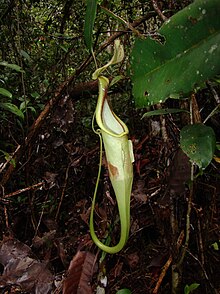Nepenthes baramensis
| Nepenthes hemsleyana | |
|---|---|
 |
|
| An upper pitcher of Nepenthes hemsleyana from Brunei | |
| Scientific classification | |
| Kingdom: | Plantae |
| (unranked): | Angiosperms |
| (unranked): | Eudicots |
| (unranked): | Core eudicots |
| Order: | Caryophyllales |
| Family: | Nepenthaceae |
| Genus: | Nepenthes |
| Species: | N. hemsleyana |
| Binomial name | |
|
Nepenthes hemsleyana Macfarl. (1908) |
|
| Synonyms | |
|
|
|
Nepenthes hemsleyana is a tropical pitcher plant endemic to Borneo, where it grows in peat swamp forest and heath forest below 200 m above sea level.
The specific epithet hemsleyana honours English botanist William Botting Hemsley, who described N. macfarlanei and N. smilesii.
This species has a long and confused taxonomic history. It was first collected in 1877 by Frederick William Burbidge, who found it on "a rocky hill about five hundred feet [150 m] high". The site was reached by a small stream and lay around 2 miles (3.2 km) from the Kedayan settlement of Meringit, located at the head of the Meropok branch of the Lawas River in Sarawak, Borneo. There the plant grew sympatrically with N. gracilis, N. hirsuta, N. rafflesiana, and N. veitchii. Burbidge informally called the plant N. rafflesiana "glaberrima", but there is no indication that this is the same taxon as the N. rafflesiana var. glaberrima described by Joseph Dalton Hooker in 1873, for which there is no representative herbarium material or description of pitcher morphology. Three of Burbidge's specimens are extant at the herbarium of the Royal Botanic Gardens, Kew: K000651484, K000651485, and K000651486. K000651485 is the designated lectotype and the other two isotypes.
...
Wikipedia
